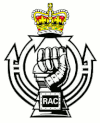Royal Tank Regiment

The Royal Tank Regiment ( RTR for short ; also Tank Corps and Royal Tank Corps ) is an association of the British Army . It is a regiment of the Royal Armored Corps divided into two battalion-strength units , but according to British custom for cavalry units they are called regiments . There is the First Royal Tank Regiment ( 1 RTR ) and the Second Royal Tank Regiment ( 2 RTR ). The motto of the regiment's Fear Naught ( Fear not! ).
history
The preparation of the Royal Tank Regiment followed the invention of tanks (Engl. Tank ). Tanks were first used at Flers in September 1916 during the Battle of the Somme in World War I. At that time, six tank companies were grouped as the hard division of the Machine Gun Corps .
After this division was separated from the machine gun corps on July 28, 1917 by royal order, it was given the official status of Tank Corps . The six companies were expanded to tank corps battalions and increased to 26 regiments by December 1918. The Royal Tank Regiment was of particular importance in 1917 in the Battle of Cambrai , when the British tried to overcome the German Siegfried Line with over 400 tanks . During the First World War, four members of the Royal Tank Regiment were awarded the Victoria Cross .
After the war, the Tank Corps was reduced to four regiments. In 1923 it was officially named Royal (Tank Corps) by George V. In 1939 the name Corps was changed to Regiment.
The regiment expanded again as many units of the Royal Tank Regiment participated in battles and operations of World War II , including the Battle of Dunkirk , El Alamein, and Operation Overlord . On D-Day, the Royal Tank Regiment used so-called Hobart's Funnies , tanks with special equipment, for example for destroying mines. Two soldiers of the Royal Tank Regiment received the Victoria Cross after the Second World War; In addition, various other awards were given to members of the regiment.
After the Second World War, the Royal Tank Regiment was again formed into two regiments ( 1 RTR and 2 RTR ). However, unity continued to play a role, for example in Kosovo .
From 1984 to 1993 the 1st Royal Tank Regiment of the British Army of the Rhine (in the Tofrek Barracks in Hildesheim ) was subordinate.
The current Colonel-in-Chief of the regiment ( Colonel of Honor ) is Queen Elizabeth II.
In 2014 the two regiments were merged into one regiment due to further reductions in the British Army (amalgamation). The regiment (battalion strength) created by the merger is called the Royal Tank Regiment.
vehicles
The Royal Tank Regiment uses (e) the following vehicles, among others:
- Challenger 2 main battle tank
- Warrior armored personnel carrier
- FV107 Scimitar reconnaissance tank
- Scorpion reconnaissance tank
- FV105 Sultan
- FV103 Spartan
- FV104 Samaritan
- HGV
- Land Rover
- Fox
- Ferret
- Centurion
- Chieftain
- Abbot
- FV 432
- Saladin
- Saracen
Web links
- Official website of 1 RTR ( English )
- Official website of the 2 RTR ( English )
- geocities.com ( English )
- Victoriacross.org.uk ( English )
